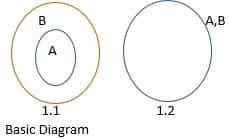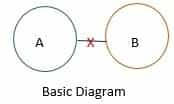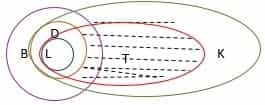The syllogism is an important part of the reasoning section of almost all of the Law Entrance Examination. Syllogism generally has high weightage and are easy to solve and that is why they are crucial for the exams. In the reasoning section of CLAT, AILET, SLAT and MH CET many questions are asked from the syllogism. Thus it is utmost important to learn and understand the concepts of syllogism to score the full marks in the exam.
A syllogism is a form of deductive reasoning where you arrive at a specific conclusion by examining two other premises or ideas. Syllogism derives from the Greek word syllogisms, meaning conclusion or inference. Some syllogisms contain three components: Major Premise. Minor Premise.
First, we will understand the basics of syllogism, How the Venn Diagram can be drawn for both Definite and Possibility cases? At the end of the article, we have provided the Link of the Video on Critical Reasoning - Syllogism & Logical Fallacy Part 1 & Part 2. Make sure to go through the article thoroughly -
| Affirmative (+) | Negative (-) |
Universal | All A are B | No A are B |
Particular | Some A are B | Some A are not B |
The case I: Universal Affirmative
All A are B
- Set A is a subset of B
- Can’t infer that “Some B are not A” (from diagram 1.2).
- It is different from “All B are A”.
Case II: Universal negative
No A are B
- Two sets, A and B do not overlap each other in this case.
- It is same as “No B are A”.
- It can be also written as “All A are not B” and “ All B are not A”.
Case III: Particular Affirmative
Some A are B
There is at least one element that is both in set A and B.
Can’t infer that “Some A are not B”.
It is the same as “Some B are A”.
Case IV: Particular Negative
Some A are not B
There is at least one element (Shaded portion) in set A that is not a part of set B.
- Can’t infer that “Some A are B’.
- It is different from “Some B are not A”.
- In this type there are two types of conclusions, one is the definite conclusion and another one is the possible conclusion. In case of, the definite conclusion you must draw a basic diagram (i.e. Minimum overlapping) and for the possible conclusion, you have to check all possible cases.
Now, let's understand this from examples:
Statements:
(1) Some Cakes are Roses
(2) All Roses are Trucks
(3) No Trucks are Bricks
(4) At least some Bricks are Hotels
Conclusions:
(1)Some Trucks are Cakes
(2)Some Bricks are Roses
(3)All Cakes are Trucks
(4)Some Hotels are Cakes
Solution: First, you should draw basic diagrams.
Now, we can see that
- Conclusion 1 is true. As Cakes and Trucks are intersecting each other.
- Conclusion 2: There is no relation mentioned between Bricks and Roses. So, we can’t comment about it.
- Conclusion3: Intersection of Trucks and Cakes is due to Roses. We can’t comment about all Cakes.
- Conclusion4: There is no relation mentioned between Hotels and Cars. So, we can’t comment about it.
Hence, Conclusion 1 follows.
Possibility Cases
In the case of Possibility cases, we have to infer all possible cases which can be possible. In exams, you don’t need to draw a diagram for each and every possible case. In this, the basic and definite condition should not be changed.
Statements:
(1) All Locks are Doors
(2) All Doors are Bags
(3) Some Tickets are not Doors
(4) All Tickets are Keys.
Conclusions:
(1)Some Locks are not Tickets
(2)Some Tickets are not Bags
(3)All Locks being Tickets is a possibility.
(4)All Keys being Doors is a possibility.
Solution:
In Statement 3 Some Tickets are not Doors, it is Case IV (Particular Negative).
- Conclusion 1: We can’t comment about this because there is more than one possible case and it is a basic statement.
- Conclusion2: There is no mention of relation to this also. We can not comment about it too.
- Conclusion 3: It is a possible conclusion, we can see that in the below diagram it has not violated the basic condition that "Some Tickets are not Doors(Dotted line portion of Tickets are not Doors)" and followed all statements given. So, it is true.
But if it has not been a 'possibility conclusion, this conclusion does not follow will be our answer

In Conclusion 4, From the below possible diagram, we can see that “All Ticket are Keys” also all Tickets are Doors. So it is violating the basic condition that “Some Tickets are not Doors”.
Hence, only conclusion 3 follows.
To help you out in your exam preparation, we suggest you take a free trial of CLAT 2022: A Comprehensive Course. Crack CLAT 2022 & Reach Your Dream NLU! So, why wait?
CLAT 2022: A Comprehensive Course
Start Free Trial Now!
The most comprehensive exam prep app.
#DreamStriveSucceed




Comments
write a comment